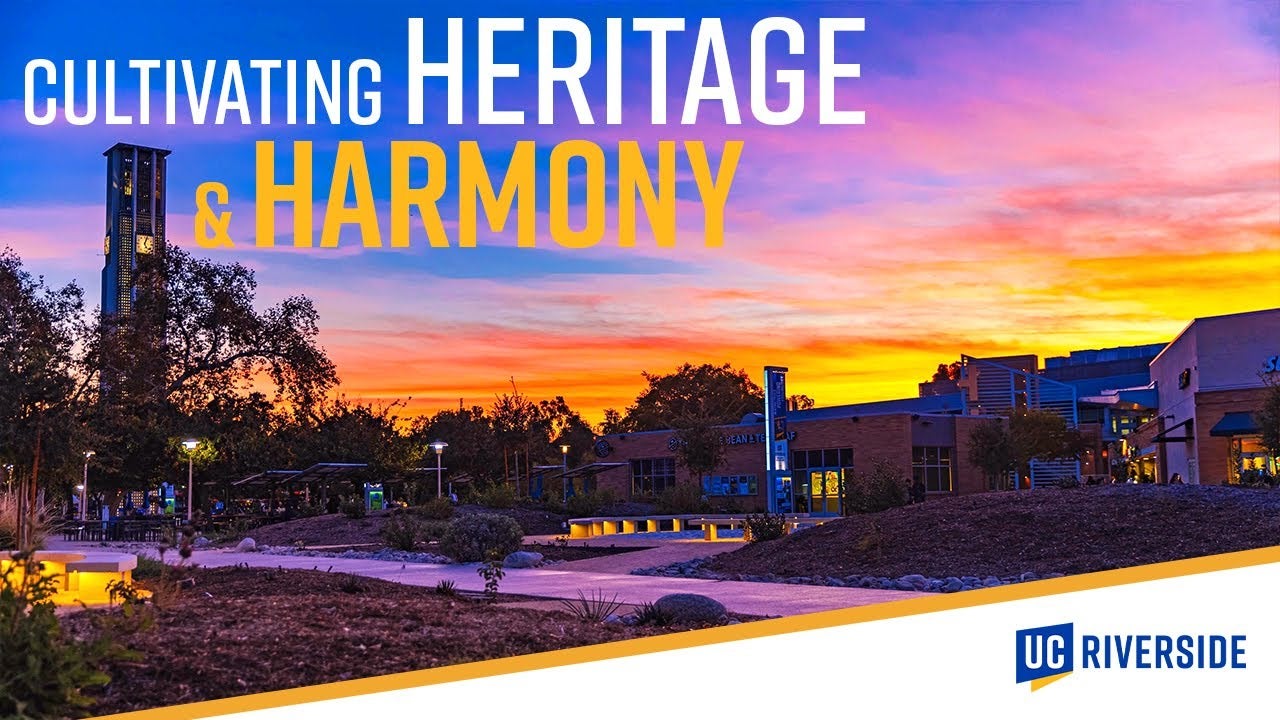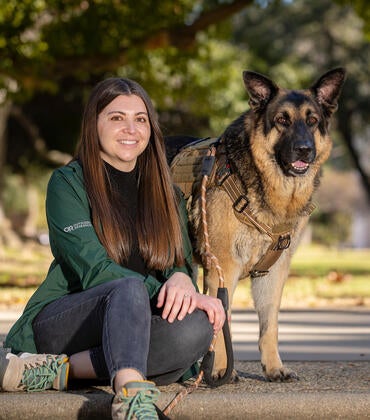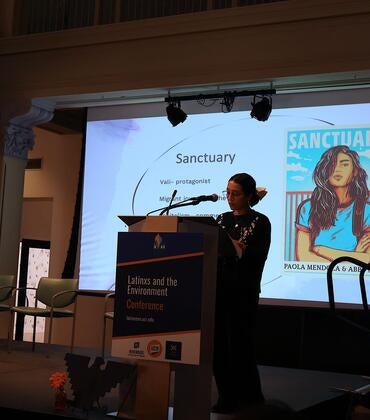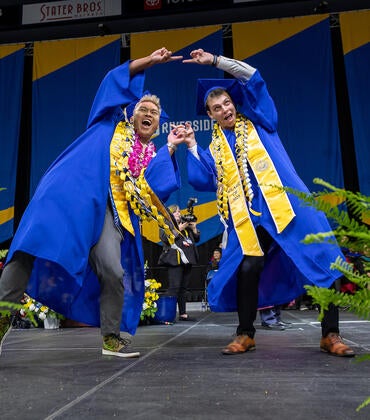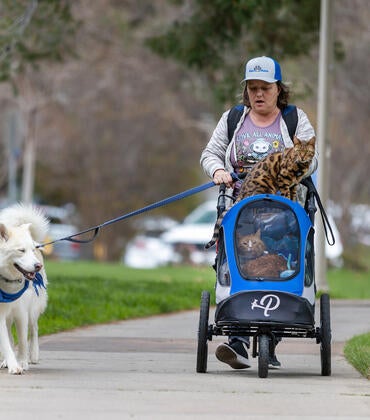Michael Madrigal, a graduate student in Ethnic and Native American studies, walks along a sandy path in the new UC Riverside Native American Garden and points out the plants that he vibes with the most. He shares the American-English name, then the Cahuilla name, and then each plant’s significance to Native American people.
“White sage, or ‘qasily.’ It’s used to cure illnesses. Deer Grass, or ‘suul.’ It’s used for basket weaving. Live oak tree or ‘wiasily.’ It is considered the ‘tree of life’ because acorns are a staple food for most of California’s Indigenous Peoples,” Madrigal explains.
Madrigal is a member of the Cahuilla Band of Indians. Before the garden was constructed in fall 2023, he’d hike through the UCR Botanic Gardens, which sits on the outskirts of campus, to feel connected to native plants. The new garden’s central location, near the Highlander Union Building and next to Coffee Bean & Tea Leaf, is more accessible and makes for more immediate grounding sessions in between classes. Madrigal now regularly brings students from the introductory Cahuilla language classes to learn in the new Native American Garden.
These plants are young and some, like the trees, will need 10 years to grow into shade-producing resources. But even in their infant stages, the plants are already inspiring unity and providing comfort, with #IndigenizeUCR, a winter final exams study break event, taking place in the garden.
The plants were chosen with intention by an advisory committee that includes Lorene Sisquoc. Her role as a Native American cultures and traditions teacher, museum board director, basket weaver, visionary award winner, author, Mother Earth Clan founder, and boarding school historian makes her a rare resource for our campus and community.
Sisquoc, an expert in Native plant uses for food and medicine, supplied the Indigenous names for the garden’s plants by contacting local tribal community language centers to get the names in Cahuilla, Serrano, Luiseno, and Gabrielino/Tongva languages.
With the garden mostly complete — there are plans for a mural and signage — Sisquoc has focused on her other campus role as UCR’s first Tribal Community Scholar-in-Residence. This role was made possible by a Mellon Foundation grant awarded to UCR’s California Center for Native Nations, or CCNN, and is designed to foster collaboration, research, and service.
Since October 2023, Sisquoc has provided the UCR community with lessons of tribal traditional values, taught awareness of local tribal communities and beyond, spoke at various classes and led hands-on workshops in basketry.
Students pursuing American Indian Studies, Ethnic Studies, or Native American History disciplines, or members of Native American Student Programs and other Indigenous campus organizations, have experienced her programming and have learned from Auntie Lori. “Native Auntie” is a term of endearment for respected Indigenous elders who carry traditions forward, teach the next generation, and play crucial roles in the wellbeing of Native communities.
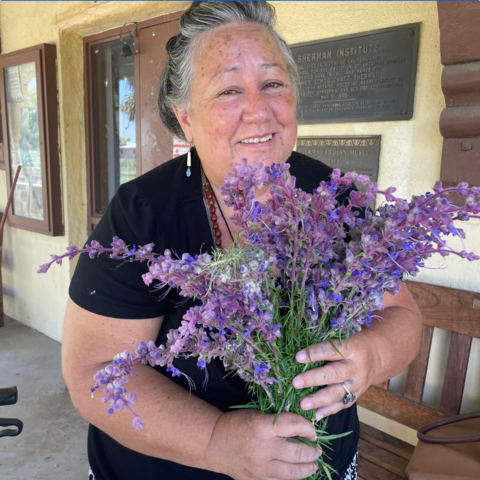
“It is an honor to have been selected for this position, I have enjoyed working with the UCR community to bring awareness of our rich cultures and traditions,” said Sisquoc, an enrolled member of the Fort Sills Warm Springs Apache and a descendant of the Mountain Cahuilla, Tohono O'odham, and Paiute tribes.
Although her role as UCR’s Scholar-in-Residence officially ends in March, Auntie Lori will continue her lifelong commitment to teaching Native American traditions in Riverside at the Sherman Indian School and throughout the world with her many publications.
For more information about the Tribal Community Scholar-in-Residence or if you'd like to invite Auntie Lori to present, please contact Gretchen Potter, UCR’s tribal liaison and coordinator for the CCNN, or its director Wallace Cleaves. Both work collaboratively with faculty, staff, students, and community members to determine priorities and support the initiatives and activities most important to Indigenous concerns. CCNN’s mission is to build Native community relationships within UCR and between campus and neighboring tribal communities.
“The contemporary uses of Native plants are vital to Indigenous peoples in realms of cultural, spiritual, and physical well-being and Lorene is a knowledge-holder on these plants and their uses,” said Potter — an enrolled citizen of the Tonawanda Seneca Nation from upstate New York.
“It has been a wonderful opportunity to have Lorene as our inaugural Scholar-in-Residence at UCR. She has long been a vital member of our campus community and her connections with the local Native community and the Sherman Indian High School allowed her to share unique insights with faculty and students,” said Cleaves — a member of the Gabrieleno/Tongva Tribal community who is enrolled in the Gabrieleno/Tongva San Gabriel Band of Mission Indians.
Upcoming event: Auntie Lori will be at the Grand Opening of the Native American Garden — a celebration and blessing hosted by Native American Student Programs, on April 9, from 12-2pm. All are welcome, including the general public.

